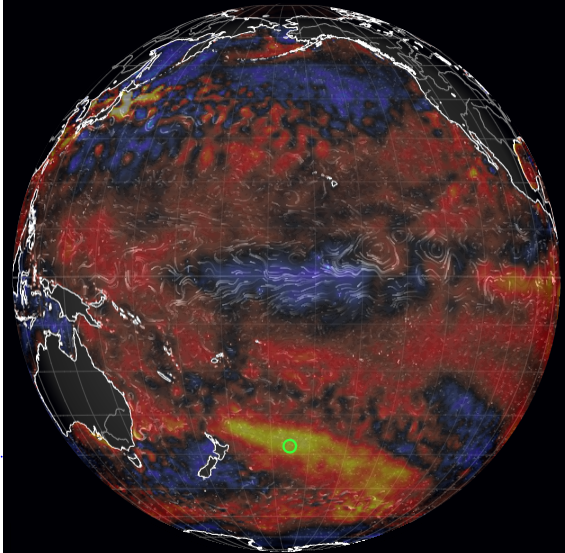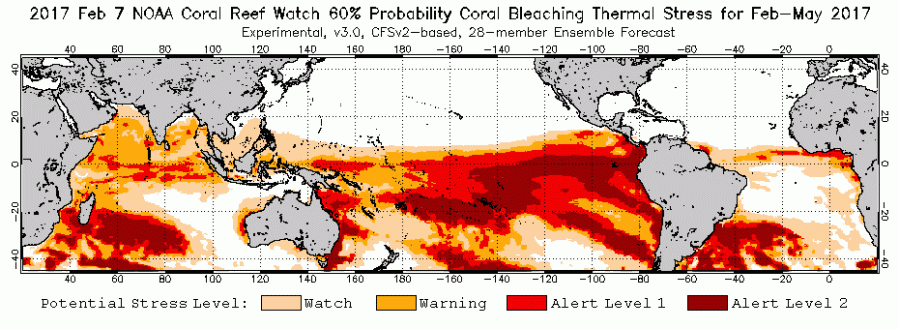The Permanent Global Coral Bleaching Event
9
February, 2017
Despite
La Nina, Ocean
surfaces have not cooled enough to end the worst global coral
bleaching event on record.
What this means is that many reefs, including the
Great Barrier Reef,
are again under a rising risk of bleaching and mortality for the
coming months. This is unheard of. Never before has a mass coral
bleaching event lasted for so long or extended through the period of
natural variability related ocean surface cooling called La Nina.
Perhaps more ominously, the global coral bleaching and die off that
began in 2014 may now be a practically permanent ocean feature of the
presently destabilized world climate system.
Cool
La Nina is Over
According
to NOAA, the
periodic cooling of ocean surfaces in the Pacific called La Nina is
now over.
And since La Nina brings with it a variable related low point of
broader Earth surface temperatures, after a few months lag, we can
expect the globe to start to warm up again.
(The
above map shows sea surface temperature anomalies in the Pacific
Ocean on February 9 of 2017. Presently SSTs over the entire Pacific
range from about -1.5 C below average to +5 C above average. And as
you can see, the Ocean is considerably warmer than normal, despite La
Nina. Over the next 1-2 years, this is likely the coolest the Pacific
will get. In just one decade’s time, under human-forced warming, it
will take a very strong La Nina and a strongly negative Pacific
Decadal Oscillation to produce similar sea surface temperatures.
Image source: Earth
Nullschool.)
Problem
is, the Earth is still ridiculously warm, despite La Nina.
Temperatures, driven inexorably higher by fossil fuel burning, have
probably bottomed out at about 1 degrees Celsius hotter than 1880s
averages during December, January and February of 2016-2017.
What
this means is that the likely range for annual global temperatures
over the next 5 years will be about 1 to 1.3 C above 1880s averages.
These readings are so high (the warmest in 115,000 years) and have
risen so much, in such a geologically short span of time, that many
of the world’s more sensitive species are now being pushed out of
their habitats and are undergoing considerable heat-related mortality
events.
Great
Barrier Reef Under Threat From Bleaching for Second Year in a Row
Perhaps
the most obvious of these horrendous fossil-fuel burning spurred
instances is the global coral bleaching event that began in 2014.
More ominously, it now appears that surface temperatures in the range
of 1 C hotter than 1880s and above may well be enough to push the
world into a permanent or near-permanent state of global coral
bleaching and mortality. What this means is that each year, from now
on, there is a considerable risk of widespread coral bleaching. It
also means that reefs impacted by bleaching will tend to have shorter
cool periods in which to recover.
(NOAA’s
60 percent certainty map shows very widespread coral bleaching
expected over the next few months. Presently, bleaching is predicted
for the region of the Great Barrier Reef. But other reef systems [see
below] fall under higher risks for considerable reef mortality events
in the current forecast. Image source: NOAA.)
For
February through May of 2017, very warm and warming sea surface
temperatures in the Southern Hemisphere are expected to produce
extraordinarily widespread risks of coral bleaching. Many areas are
predicted to see the highest coral bleaching alert level NOAA has a
measure for.
Multiple coral reef regions are already experiencing Alert Level 1 bleaching stress (associated with significant coral bleaching). Alert Level 2 bleaching stress (associated with widespread coral bleaching and significant mortality) is expected in the Northern Cook Islands, Southern Cook Islands, the Samoas, Wallis & Futuna,Northern Tonga, Southern Tonga, the Society Archipelago, and the Austral Islandsin the next 1-4 weeks. Alert Level 1 bleaching conditions are also expected in theTuamotu Archipelago in the next 1-4 weeks and in Tuvalu in the next 5-8 weeks.
The
prediction map also includes the potential for high alert levels
(level 1) for sections of the Great Barrier Reef which last year
experienced its worst coral bleaching event on record. Needless to
say, a second year of bleaching would be a devastating additional
blow to a critical ocean life support system and one of Australia’s
priceless national treasures.
Links:
Hat
tip to George Hayduke





No comments:
Post a Comment
Note: only a member of this blog may post a comment.